The Livescribe Smartpen and Accessibility
Click here to access my podcast

Livescribe Echo Smartpen

Dot Positioning Paper used to record lectures to sync with written notes
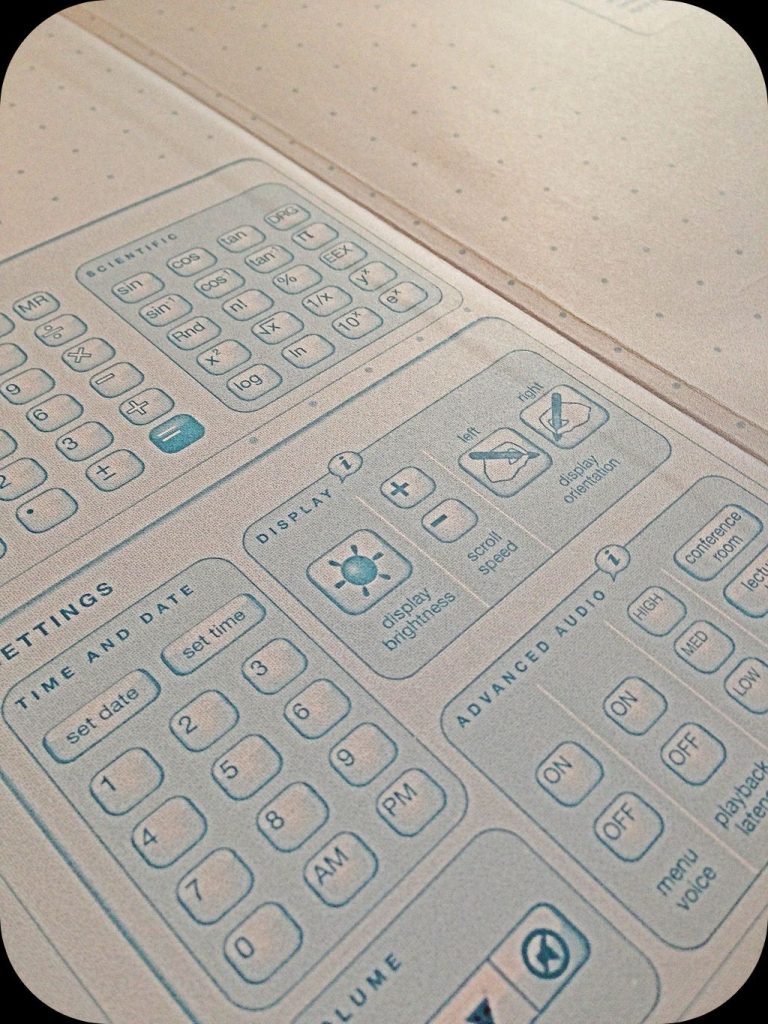
Additional tools in Livescribe notebooks

Click here to access my podcast

Livescribe Echo Smartpen

Dot Positioning Paper used to record lectures to sync with written notes

Additional tools in Livescribe notebooks

Blocker Bracelet was created in response to the widespread shortage of ‘reallife’ artists. What are ‘reallife’ artists? Reallife artists proliferated the music scene up until 2020. They can be impossible to detect as there is no physical way to tell them apart from algorithmic artists. Real life artists are different, as they do not use inner ear pieces to create music from algorithmic feeds.

The Blocker Bracelet alerts ‘reallife’ artists to any algorithmic ear pieces within 5 metres.
The creation of Blocker Bracelet was funded by the National Music Archival Society of Canada.
——-✹——-✹——-✹——-✹——-✹——-✹——-✹——-✹——-✹——-✹——-✹——-✹
How did it all begin?
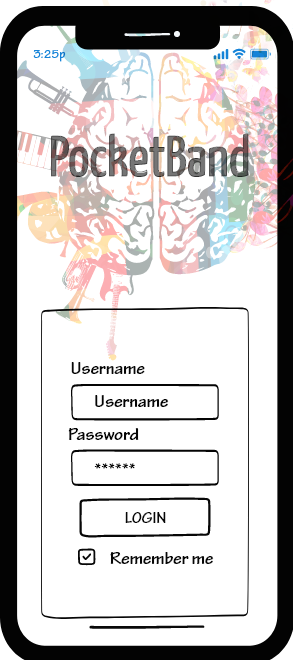
These snippets of speculative fiction were born of of a design I created for another class, PocketBand. Pocket Band is a mobile algorithmic band app that allows musicians to create music with an algorithmic ensemble instead of real musicians. I created this app because I genuinely thought it would make my life and the life of other artists, better. When I started task 12, I thought of our discussions about the way we interact with text. I also contemplated the question about how things would change if algorithms appeared in the public space and at the forefront of creation. I tried to bring together what we learned from past weeks about the preservation of knowledge (Brown University, 2017) and machine bias (McRaney, n.d.). During the design process of PocketBand, I tried to give the user as much personalization as I could, including the ability to choose the country of origin that algorithmic melodies would be based on, and the ability for individuals to record their preferred musical styles.
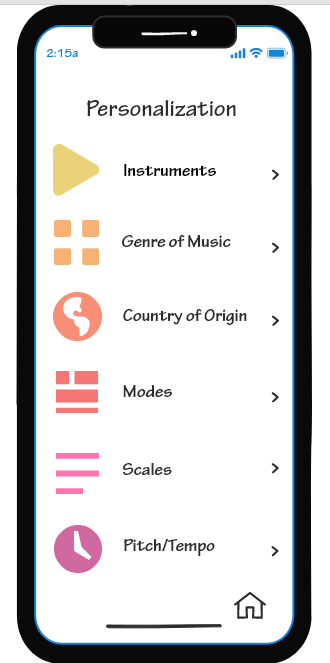
Despite all of the options for personalization, my speculative fiction highlights the future impact of a technology like PocketBand, and asks the question whether or not this new mode of creation should replace ‘realtime’ artists. Adding to that, would a technology like this one, ‘replace’ anyone, or is it simply a new artistic medium? I imagined a future where additional technologies were created after PocketBand, such as an earpiece for hands-free/discrete algorithmic composition, and a Blocker Bracelet funded to preserve a dying mode of creation. The earpiece and bracelet were imagined as critical designs, to “…confront us with alternative needs and hint at a parallel world…”(Dune & Raby, 2013) like the release of the JoyCam, after photography became digital.
If you are interested in viewing the full project, please click here:
Brown University. (2017, July 11). Abby Smith Rumsey: “Digital Memory: What Can We Afford to Lose?” [Video] YouTube. https://youtu.be/FBrahqg9ZMc
Dunne, A., & Raby, F. (2013). Speculative Everything: Design, Fiction, and Social Dreaming. Cambridge: The MIT Press.
McRaney, D. (n.d.). Machine Bias (rebroadcast). In You Are Not So Smart. Retrieved from https://soundcloud.com/youarenotsosmart/140-machine-bias-rebroadcast
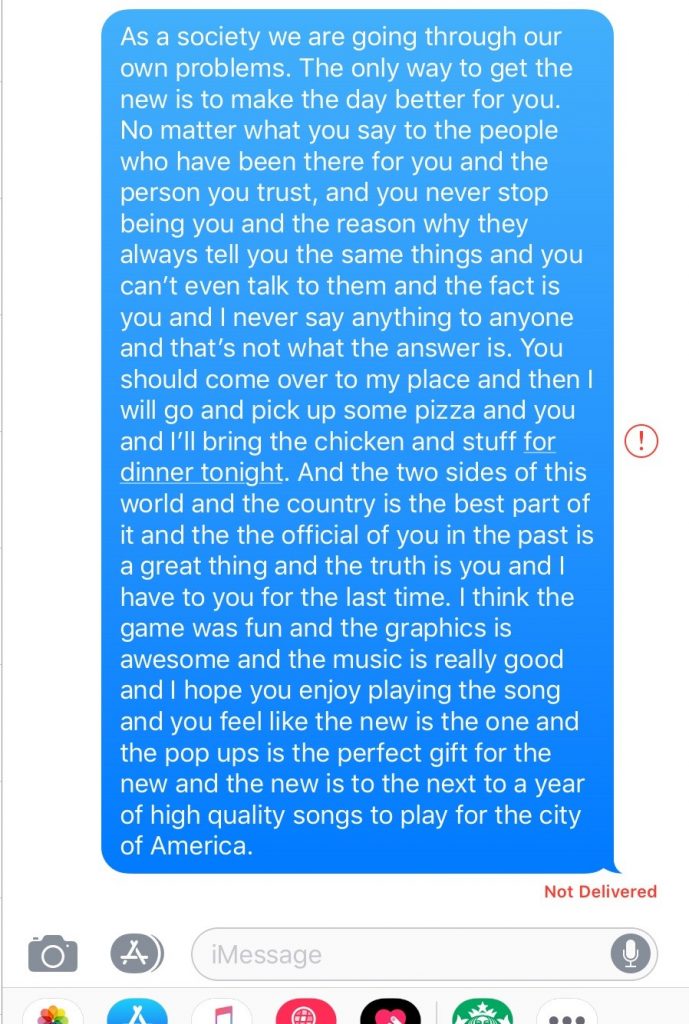
When writing my microblog entry, the first thing that I noticed was how difficult it was to write anything serious. I started the activity, seeking to address how we as a society, spend a lot of time editing our conversations before we send them via text. Instead of that message being relayed, I had to choose from very simple concepts and words. “You”, “I” and “and” came up very frequently, and it was sometimes hard to break out of the pattern of using one of those three words. Because of the simplicity of the predictive text, I am hard pressed to say that I have read anything like I have written, besides in a text message or a very simple note I may have received from a friend in grade school. The most complex words I produced are probably: pizza, chicken, music, graphics and pop-ups, which shows that the algorithm my iPad uses has adapted to repeat what users have selected in the past (McRaney, n.d.).
The statements produced by the predictive text are different than how I would usually express myself, because they don’t really follow a formula. I have been tutoring K-12 writing online now for a couple of years, and often go over how to state an argument in writing. When making a claim, such as “As a society we are too concerned with controlling how we are seen”, it strengthens the statement to follow with evidence (supporting ideas) and an analysis (a statement to glue everything together). When choosing from options that the algorithm provided for me, I was unable to give anything but a series of unrelated claims. The nature of writing is that it is a creative process where the writer’s strength lies in their ability to artfully relate ideas to one another. Predictive text algorithms aren’t created to replicate this process, but instead exist for speed and convenience. An AI’s limit starts where unfamiliarity begins (Santa Clara University, 2018).
The use of algorithms in public spaces is dangerous because there is a large threat of cultural exclusion. When writing my microblog, why was I only offered the food words “chicken” and “pizza” to choose from? What about arroz caldo, or cod cakes? Groups of people who are already underrepresented will continue to be so, but at a faster rate, as writing algorithms will accelerate (Santa Clara University, 2018) cultural ‘norms’ while phasing out others. As stated by O’Neil, algorithms adapting to show individuals different political information has already threatened democracy (The Age of the Algorithm, n.d.). If algorithms were used in academia and education, we may not share the same knowledge base as people in other countries. Our histories and futures never may never intersect, but instead run parallel. Businesses may also begin to stagnate, unable to generate new and innovative ideas.
McRaney, D. (n.d.). Machine Bias (rebroadcast). In You Are Not so Smart. Retrieved from https://soundcloud.com/youarenotsosmart/140-machine-bias-rebroadcast
Santa Clara University. (2018). Lessons from the AI Mirror Shannon Vallor.
The Age of the Algorithm. (n.d.). In 99 Percent Invisible. Retrieved from https://99percentinvisible.org/episode/the-age-of-the-algorithm/
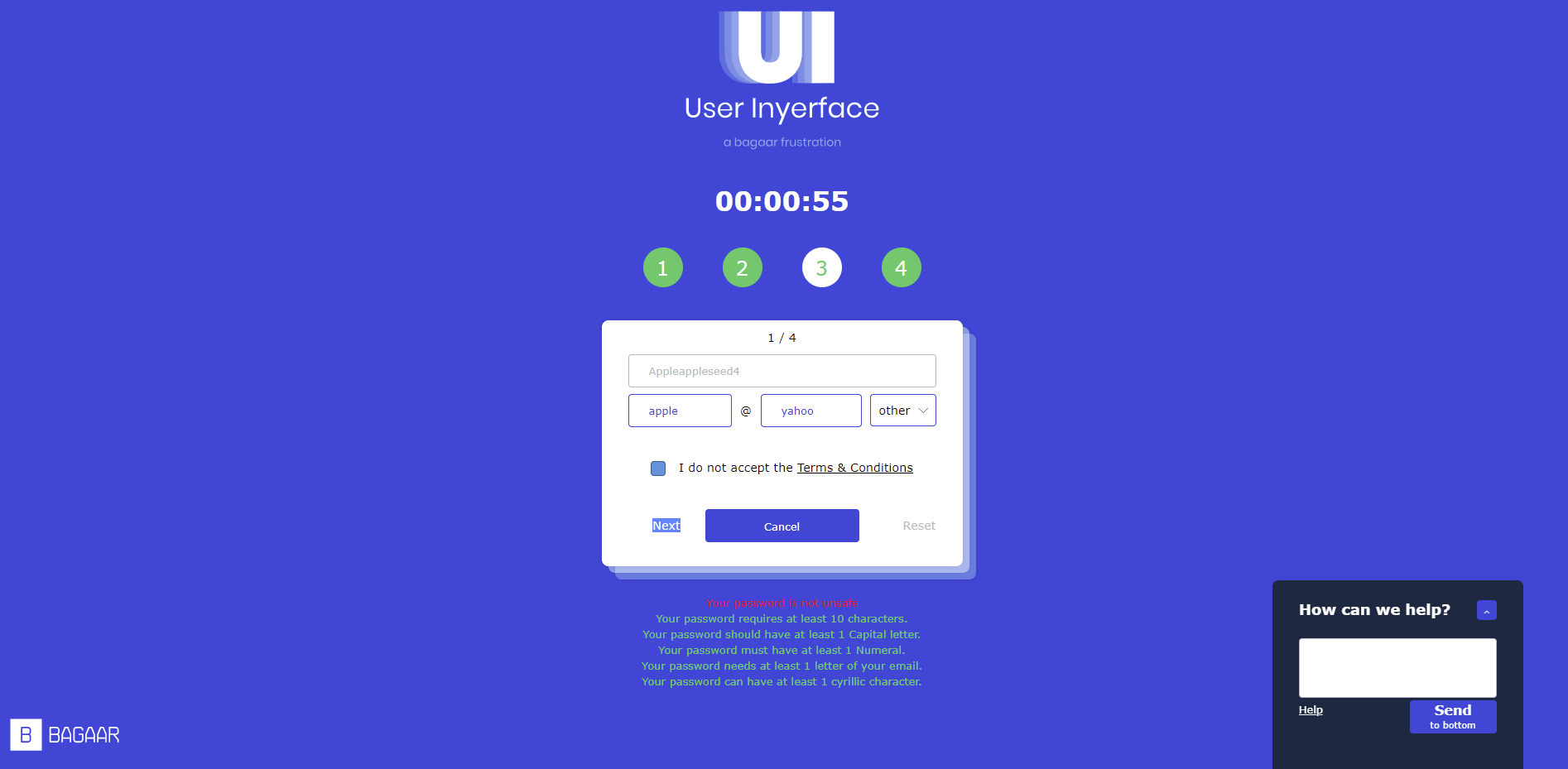
When I played the User Inyerface game, I felt proud to have gotten to the forth page! Unfortunately, I was using a new screen shot app that didn’t autosave, and I was left with only the very first image I took with my old screen capture tool. Let’s just call this photo, “The beginning of frustration”.
Interacting with this interface reminded me ALOT of how I feel when I try to use Glassdoor.com. When ever I attempt to read any employee reviews of their jobs at particular companies, a shield moves down to cover all of the information. This has forced me to get an account, and even after I did, I was then prompted to enter my salary information before I was allowed to see any of the reviews. As I played User Inyerface, I realized that no matter how much I clicked in the ‘expected’ locations, the actions I wanted to execute did not happen. I continued anyways, as “The problem with addiction is that it deprives the victim of agency, even when an addict understands the potential for harm, he or she cannot help but continue the activity” (McNamee, 2019). Only after many errors did I figure out that I had to arbitrarily click on random places to move to the next screen or to close unwanted pop-ups.
One of the ways my attention was being directed by the interface was through the necessity to make rash decisions based on time. This feeling of hurriedness existed even though the loss of time, indicated by the the pop-up clock and syncopated seconds, lead to no consequence. I was not kicked off, and I never actually ran out of time. What did happen, is that I felt disorientated and continued to click randomly around, just to accomplish something. What that was, I still don’t know. I also entered an email and password with a shared letter, even though I knew that it was the wrong thing to do. I did it merely to move on!
One of the other devices used to capture my attention, was a slow response time. When I chose the option to send the ‘help’ box down to the bottom of the page, it moved very slowly. I stared at it wishing it would go away. When I tried to use the ‘help’ box for actual help, it auto filled my question to some strange word. Maybe it was only put there to collect my data? When I opened the ‘terms of agreement’ window, the scroll bar felt heavy and I had to drag my hand super hard for it to move anywhere. I could see on the side that it was quite long, and this filled me with dread, thinking how much effort it would take to read these terms. Like Harris (2017) mentioned, I was reacting from my lizard brain. From the way I was interacting with this site, it was difficult to know whether or not I was in fight or flight.
When the interface told me that I was almost finished, I felt a mix of relief and disbelief. I spent a little bit longer than I wanted to, trying to choose the correct pictures to prove that I wasn’t a robot. I did this despite the fact that I knew there wasn’t enough circles to indicate my selected photos. Was I choosing the images on the top or the bottom of each circle? I gave this page about 7 or 8 passes, because 1) I am stubborn and 2) I was being persuaded to spend more time on screen (Harris, 2017). In the end I was left wondering if it was all just a rouse, and if there really was a next page, as there were too many ways to interpret each option, and no way out. Tufeki stated that “We know longer know if we are seeing the same information…”(2017). When considering this ‘non-robot validity test’, what do people in other countries see if on the same website. Do they also have to choose between multiple homonyms? If I use glasses to see and someone else uses glasses to drink, would I have to develop a matrix of answers before being able to prove I am human? The promise of a reward kept me clicking.
Harris, T. (2017). How a handful of tech companies control billions of minds every day. Retrieved from https://www.ted.com/talks/tristan_harris_the_manipulative_tricks_tech_companies_use_to_capture_your_attention?language=en
McNamee, R. (2019, January, 17). I mentored Mark Zuckerberg. I loved Facebook, But I can’t stay silent about what’s happening. Time.com. https://time.com/5505441/mark-zuckerberg-mentor-facebook-downfall/
Tufekci, Z. (2017). We’re building a dystopia just to make people click on ads. Retrieved from (Links to an external site.)https://www.ted.com/talks/zeynep_tufekci_we_re_building_a_dystopia_just_to_make_people_click_on_ads?language=en (Links to an external site.) (Links to an external site.)
When looking at the results from the record curation quiz data, I see the shared choices for single songs that we ‘cant afford to lose’ (Rumsey, 2017) from the Golden Record collection. I don’t know how others felt while choosing which songs were of the utmost importance to keep, but for myself it was an awkward process. After listening to Rumsey’s (2017) talk last week, I was torn between establishing a quick filter for selection, while at the same time, feeling burdened by the consequences of the wrong choices. While looking through other student’s blog spaces, I noticed that my apprehensiveness at the task was mirrored. In one blog, its author decided to chose songs that didn’t have lyrics and that evoked emotion: https://sites.google.com/learn.sd23.bc.ca/540-course-work/weekly-assignments/task-8?authuser=0. Another blogger, chose songs to keep according to the variety of instruments they used, and their tone and melody: https://blogs.ubc.ca/etec540judytai/2021/03/05/task-8-golden-record-curation-assignment/. Knowing that the selection process in the end was arbitrary and completely subjective to each person, the weight given to each song no longer seemed to hold any real significance.
As we see in this screenshot, where I chose to view the song data by node weight, we can see that Track 14: Melancholy Blues, was considered essential by many participants. While looking at the same image, we can also see that Track 18: Fifth Symphony holds less weight. Although more people selected Melancholy Blues as important to keep on the record, for a number of varied reasons, we still have to remember that the song was chosen based on the experiences and perceptions of a certain group of people. If we look at one of the student filters I shared above, the musicality of a piece, we must consider what is considered musical to one person, may seem bland to another. What we seek depends wholly on our contexts and interests. Maybe if we had taken a quiz ranking the ‘best’ filters to use when choosing the songs, the results would have been closer to objective, but never completely there.
If we look at this second image, we can see that there are some outliers. These song selectors have no links to other members. This is probably due to the fact that they had unique opinions about what songs should stay on the Golden Record. Some of the songs also lack links to others. When watching The Internet: How Search Works (Code.org, 2017) I learned about how the internet doesn’t search in real time, but instead has a compiled database based on prior searches. This means when I am searching for an answer to my question, the answers I receive are a compilation of other ‘popular’ questions and answers. The political and educational ramifications of this are huge, as individuals who are searching, but not represented through the online database, may only have access to information that is popular. This doesn’t account for whether or not a person’s search results are true, valuable or applicable to them. Task 8 and 9 have shown us that arbitrary selection choices, about what to document, may change our very knowledge base! As Rumsey (2017) mentioned in her talk, our choices for what to keep can impact whether or not we look back on a false narrative.
Brown University. (2017, July 11). Abby Smith Rumsey: “Digital Memory: What Can We Afford to Lose?” [Video] YouTube. https://youtu.be/FBrahqg9ZMc
Code.org. (2017, June 13). The Internet: How Search Works . Retrieved from https://youtu.be/LVV_93mBfSU
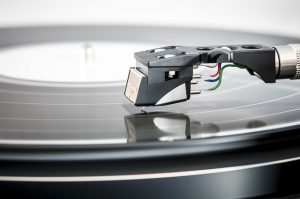 This task was very difficult for me, as I kept hearing Rumsey’s (2017) words in my head, “How do we reflect process of history making?”. One of the considerations that helped me to decide what to keep, was which songs on the Golden Record could give future listeners a glimpse into our imagination (Rumsey, 2017). When choosing songs that I felt could accomplish this feat, I tried to choose pieces that pushed boundaries musically, or ones that used different musical modes. My second thought, when choosing what songs to keep, was that I should select songs with different contexts. Although all music is composed within a certain context, I picked songs that displayed rights of passage or roused people for significant events, like battles. Because I could only pick 10 songs to go on the record, and I wanted to steer away from depicting a monoculture (Rumsey, 2017), I also tried to include music that belonged to communities, such as Indigenous and folk music songs. Although I chose my final list with the the three categories in mind, I was also aware that all of these songs belong to overlapping groups, making the process more complicated.
This task was very difficult for me, as I kept hearing Rumsey’s (2017) words in my head, “How do we reflect process of history making?”. One of the considerations that helped me to decide what to keep, was which songs on the Golden Record could give future listeners a glimpse into our imagination (Rumsey, 2017). When choosing songs that I felt could accomplish this feat, I tried to choose pieces that pushed boundaries musically, or ones that used different musical modes. My second thought, when choosing what songs to keep, was that I should select songs with different contexts. Although all music is composed within a certain context, I picked songs that displayed rights of passage or roused people for significant events, like battles. Because I could only pick 10 songs to go on the record, and I wanted to steer away from depicting a monoculture (Rumsey, 2017), I also tried to include music that belonged to communities, such as Indigenous and folk music songs. Although I chose my final list with the the three categories in mind, I was also aware that all of these songs belong to overlapping groups, making the process more complicated.
Here is my (not so confidently chosen) list of the songs that will stay on the Golden Record:
Category #1: Imagination
Category #2: Contexts
Category #3 Communities
Brown University. (2017, July 11). Abby Smith Rumsey: “Digital Memory: What Can We Afford to Lose?” [Video] YouTube. https://youtu.be/FBrahqg9ZMc
When redesigning task #1, I had to first think of what the significance was of the ‘bag’ in the “What’s in Your Bag?” activity. I realized that the bag served as a mobile container for important tools that needed to be accessible it’s carrier, from one environment to the next. In September, I took a course on assistive technology (AT) through Athabasca University. Here I learned about how tablets and smartphones can operate as (AT) because of their portability. These devices can also be preferred by their users because they don’t attract much attention. I used this knowledge, of these technologies as tools, to redesign Task #1 for someone who is blind or has low-vision.
To redesign the task, I had to research what type of adaptations existed for people who are blind or have low-vision, when using technology. This included adaptations needed to perform “common” functions in an educational setting. Examples of these included: how to copy and paste, find buttons and switch tabs on the computer. I also had to differentiate between different learners who use different tools, such as a braille keyboard, voice to text, screen reader, etc..
In activity #1, I asked the learners to talk about the apps on their mobile device, because I thought that it was one way that each individual could express their personalities, passions and how they move through the world. I did this with the words of the The New London Group (1996) in mind: “Designing will more or less normatively reproduce, or more or less radically transform, given knowledges, social relations, and identities, depending on the social conditions under which Designing occurs”(p.75). I tried to empower each learner to share the apps that they felt represented their identity best.
For activity #2 I wanted to activate discourse around using mobile tools. I looked up the most accessible social media platforms for individuals who are blind or low-vision, and Twitter came out on top! I decided to implement a tweeting activity to enhance discourse: “…(discourse) draws attention to the diversity of constructions (representations) of various domains of life and experience associated with different voices, positions, and interests (subjectivities)”(the London Group, 1996, p.78). I also wanted the activity to extend beyond the space of the course, and into the public realm and the learners chosen community space or lifeword (The New London Group, 1996, p.71).
One of the benefits of changing modes for this task was that I became more aware of how other people access information. I realized that I had never thought about how someone who is blind or low vision would find hyperlinks, discussion boxes and ‘submit’ buttons on the screen. I realized that for some individuals that audio, spatial and visual design (colour contrast), is very important to access information (The New London Group, 1996, p.83). I also recognized, through this activity, that spatial, technological and aural literacy must be much higher in people who lean more on other senses than sight. After looking at some of the accessibility features on Android phones, I think that people who are blind or have low vision, may also have strong executive function capabilities. I say this, because a lot of information is stored in categories or containers on mobile phones through accessibility functions. This makes related information stay grouped together, almost like nodes in the brain. The ability to read and write braille is also another type of literacy; the ability to communicate and receive ideas through touch.
One of the challenges of engaging in the redesign activity is that I found myself wanting to change a lot of the original activity, but I didn’t want to stray away from the initial task too much. It was also a challenge to design for learners with a variety of abilities, without assuming too much about what those abilities looked like, and what literacies each individual uses the most.
The New London Group. (1996). A pedagogy of multiliteracies: Designing social futures. (Links to an external site.) Harvard Educational Review 66(1), 60-92.
When I was writing my emoji story, I first started for looking for symbols with the same phonetic sounds of the title. I was searching for very specific symbols, like a person with a cape, and began filtering through all of the different sets with no luck. After some time, I started to realize that the system of trying to convert written text into symbols, by relying on the sounds of written text to be conveyed through the emojis was unsuccessful. This was because, even when I found an item, that could be used to relay a phonetic sound, it was questionable whether or not the reader would perceive the symbol as representing the speech sound I wanted it to. For example, I used, what I perceived as, a bowl of soup to make a “suu” sound, but then I realized that some people may view the soup bowl as ‘noodles’ instead. This would depend on their experience, as “(The) Agency of the individual who has a social history, a present social location, an understanding of the potentials of the resources for communication, and who acts transformationally on the resources environment…” (Kress, 2004, p.20) influences how individuals perceive symbols. Because of the subjectivity of symbol translation, I think that it is very difficult to translate a medium that was written in one mode, into another. It takes users of augmentative communication devices, which can use many different symbol sets, a long time to be able to learn and communicate using the new language of symbols.
In the end, I decided that he best way to provide the plot of the TV show I watched, was to shape the reader’s experience through the relation of emojis instead. I did this by placing the symbols in approximation to one another, using spaces or positions to depict a break in thought, or new element of the plot. I also used arrows to depict movement, whether or not that included movement in time, an unfolding event or an emotional state by one of the characters. Kress (2004) discusses this action as a practice of traditional writing, “This gives authors a specific power: readers are dependent …on sequence and sequential uncovering”(p.13). By doing this, I realized it was hard for me to let go of “…an entry point given by convention and used by the author” (Kress, 2004, p.9) as I forced my reader to follow my guide along the page.
References
Kress, G. (2005). Gains and losses: New forms of texts, knowledge, and learning. Computers and Composition, 22(1), 5-22. doi:https://doi-org.ezproxy.library.ubc.ca/10.1016/j.compcom.2004.12.004
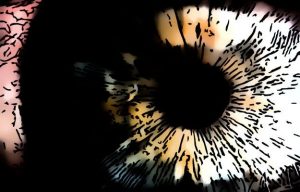
please click here to download and play Siouxsie’s Office Adventure
you will be re-directed and have to click on the link again
When beginning to craft my interactive story, I had to first think about what the main theme of the story would be. Because the interactive story had to give the reader alternate routes to the same conclusion, I had to work backwards from the story’s ending. I filtered through ideas and decided to disregard any that weren’t rich enough to provide alternate paths. Although the first conception of my story involved a tale about my dog’s adventures and a suspenseful thriller, I decided upon a story that exposed the mind of a character who suffers from anxiety.
The anxious mind, in a way, operates like a “Choose Your Own Adventure” novel because the anxiety sufferer often has to choose between difficult thought processes that drive certain actions. As someone who has anxiety, I know about this process (ruminating) all too well, so in this way, this is also my story.
My process behind planning for Siouxsie’s Office Adventure started with creating a story map with pen and paper, where I planned out two separate event paths to the same conclusion. I choose to use pen and paper for the initial stages in the story production, as with using these materials I am able to record my thoughts as they quickly change, allowing for more immediacy in the planning process. Bolter (2001) discusses how the mind works to move along a string of ideas: “Vannevar Bush…wrote that “…the human mind…works by association. With one item in its grasp, it snaps instantly to the next that is suggested by the association of thoughts, in accordance with some intricate web of trails carried by the cells of the brain…””(Bolter, 2001, p.42).
When I was happy with my story web, I began to type the script into Twine, paying careful attention to what words or phrases I wanted to use to trigger the next event. This was important for me, as I felt that the way a trigger or hyperlink appears helps the reader to organize what the focus is of the new information stream. In a way, the hyperlink label frames your next experience: “The principal task of hypertextual fiction on the Web or stand alone form is to use links to define relationships among textual elements, and these links constitute the rhetoric of the hypertext”(Bolter, 2001, p.28).
I then previewed the story, making sure that it thematically flowed. After this, I choose pictures from Unsplash, resizing and ‘cartoonizing’ the images I found. I did this to give the story a more graphic feel. Adding the images took a long time at first, as I am not well versed in html, but after doing it a few times my level of comfort increased, and the appearance of the coding language became natural to me.
A big dilemma that I had was whether to put the photo credits directly under the pictures or to shift them downwards, away from the readers direct sightline. I felt that the credits competed for visual attention with the story, so in the end, not knowing how to change the colour of the citation text, I decided to keep the appearance of the story more minimal to give the best experience to the reader.
I proofread the story many times after all of the elements had been implemented, but I will be honest, that as the author of Siouxsie’s Office Adventure, I have a deep desire for its readers to engage with all possibilities of the story’s plot. I know that this is selfish of me, as hypertext in an interactive story doesn’t exist to merely layer integral information, but as Bolter (2001) argues, to provide a customized experience for the reader: “Because every path may define an equally convincing and appropriate reading, the hypertext’s multiplicity (or overdetermination) suggests a changed relationship between the reader and and the text” (p.35).
Bolter, J. D. (2001). Writing space: computers, hypertext, and the remediation of print. New York, NY: Routledge.
click here to see my photo references https://jenriego.wixsite.com/siouxsie/blank

Note_2, 28 Jan 2021
——————-
One time I decided to go do what things so that’s when you go to another place where you learn to do organic farming all over the world so I did one that was in Columbia it’s kind of strange because the guy who who needed help me a coffee farm and it was in a space for the Sierra Nevada up by Santa Marta near Cartagena Colombia I’ve never been there before but he was just Adam and he I guess when the when the states went through their big their big recession or like economic downturn he lost his house and he said he worked at Hard Rock Cafe music coaxer you had $5,000 the property on the top of this mountain so he said we decide to go there but there’s always these kind of rules that are Carly unspoken there they’re also spoken where you know when you go visit the person and you’re helping them do organic teaching you are doing labour for them but at the same time they’re supposed to feed you so the first part of leg is that the Adam guy said we needed to bring vegetables from Santa Marta so please bring vegetables from Santa Maria carrots potatoes whatever and I was thinking okay he’s supposed to supply us with food but that was the first one so then we had you can have to take mortal tax the mountain it’s like a 3-hour cycle ride on these taxi so you just hold on to the back of somebody in and go up and it’s really a Rocky and so me and my boyfriend at the time had to have each had a grocery bag full of this really heavy root vegetable wrapped around like you know our arms are around the the chests of these guys regeneron mototaxi and then the vegetable like is so Rocky there just thrashing around backward 4 or arms or Flex so hard trying to hold on to these vegetable bags anyway yeah it was a bit of a painful experience but I guess you know it wasn’t a big deal but it was the first red flag second one cul-de-sac casey said that his friend you had another piece of property that he was gone on vacation so that we could stay in his farm house so that Adam guy would stay in one farmhouse in between the other farm house and then threw pretty excited so we brought some kind of like stuff to make music just for our downtime you know and then when we got there it wasn’t the truth we were sleeping on a dirt floor basically sharing a bedroom with him so he had a single blow-up mattress and and there was saloon doors and then his room was a sit-down. Saloon doors he went to bed at 8 p.m. Turn the light to Joint light between our room in his room so he turned off his his light we’re also in the dark at 8 so I mean we couldn’t even really talk about her experiences because he was he was in earshot distance the whole time but anyway we’re just lucky that we bought a mosquito-net because that’s malaria like a malaria area so we just kind of you know each
other on a single mattress and we put the put the mosquito net we hung up from a beam on the ceiling and wrap it under the mattress on the on the dirt floor and in the morning when we would wake up kind of like weird scorpion looking spiders all over the net so I’m so glad that we had that Nets that was the second red flag that he kind of Dino promise one you didn’t fall through with if he had just said that in the beginning and that’s being honest and you know we could have made our decision from then but he promised something totally different the server flag is that you know we would work for 8 hours and then we would kind of like start winding down and then he would start yelling at us and say like you think you’re finished I went through all the areas where there was a coffee beans in there so some some that you guys didn’t see when you are making a passenger Viking coffee beans from from the trees right so basically wants to work 12 hours a day what do you want us to work 12 hours and then you wanted and then we were feeding ourselves essentially and then we couldn’t even really get proper sleep and we couldn’t even have a conversation without him around like spying on us like not not purposely but he was so close to us that there was no way that we could have any free thought free time free anyting so we committed for we had committed to him urgently for 2 months cuz he really wanted to learn how to do organic farming so she organic coffee farming but then because he was being so unreasonable and it was just to get spoiled if next expected then decided to leave so he agreed I I said to him I think that you know this is not really a big screen as we signed up for in all honesty there had been other Clues to like she’s girlfriend who lives in Santa Marta who is helping with this project to to neuter and spay homeless dogs and cats she said that you know he had always had problems with Pikepass woofers for woofers because it didn’t work hard enough and so I should have planted that as a clue that if he has a problem with every single person coming up petition for 2 High anyway he told us in the morning there’s a Chiva like a truck looking to pick up all the farmer if it’s mostly a farmer like an indigenous unity after you take all the farmers. So you can catch it so in the morning we waited at the spot for this truck and that was one of the best experiences of my life I’ll be honest with you you’re something probably never experience again like riding on a truck like that going down it was really scary when they covered the hole the whole thing with a black tarp it’s frightening when you’re in the pitch-dark where’s Donna mountain and you can’t see anything but it was one of the finest experiences of my life even though that guy didn’t really you know he wasn’t a positive experience but I will say that the trip was from what we
learned and what we learned about you know we stepped out of her comfort zone and we learned a lot
Speechnotes 🙂 https://speechnotes.co
———————————————————————————————————————————-

This story deviates from the conventions of written English because it has very little punctuation, and capital letters are used sporadically. Because of this, it is difficult to tell where one thought ends at another one begins. This whole story is written as a big block with no organized sections. This makes reading it a bit of an exhausting experience, as your eyes do not get to rest. Because some of the words were misread/misspoken, the sentence structures also do not make sense. I use ‘like’ and ‘you know’ often in this story, which are often frowned upon in written English. Ong argued that “…writing transforms human consciousness by moving language from an aural realm, where it unfolds across time, to a visual realm, where it takes on primarily a spatial quality”(Hass, 2013, p.9) I believe that if the spatial quality of the writing doesn’t emulate my spoken speech, giving us instead, a broken translation.
The part that is right in this story, is the order of events. Even though the text is confusing, I still think that the reader can tell what happened at the beginning, middle and end of the story. You can still tell where the story took place, and who the main people are. Although the details become jumbled at times, I think that the main point of the story is not lost. I do feel like the story feels flat, and that a lot of the emotional nuances are lost, because the reader is too busy teasing out details. Many of the single words in the story are wrong. For the story to be fully effective as a psychological tool, or one that can ‘modify others’, the text would have to follow the agreed upon conventions of our culture (Hass, 2013, p.15).
The most common mistake in the text is the word substitution. Some examples are words like ‘unity’ instead of community, ‘Donna’ instead of ‘down the’ and ‘Mortal tax’ instead of ‘mototaxi’. I consider them mistakes because they are not the words I intended to use. This makes me question whether the message communicated by text is to be measured by the intention of the author, or how it is perceived. Schmadt-Besserat & Erard (2009), discuss how “…writing is a technology that restructures the consciousness of individuals who use it and refocuses the energies of societies that utilize it (Ong 1982) (p.20). Because the writing that is displayed is different from the spoken text that I recited, the result is a sort of scattered consciousness that cannot be picked up by others.
If I had scripted the story, I probably would have edited it a few times. I would have taken out any ‘inappropriate’ casual sounding language and I would have decided, in a planning phase, which details were important to include. When I decided to use this story for the activity, I actually thought that a majority of the entry would be about the voyage down the mountain. As I started to speak, the focus of my story changed to the ‘red flags’ of the experience. Stories evolve depending on who we are telling them to.
Oral storytelling differs from written storytelling in that it evokes more emotion. The qualities of the storyteller, can completely change how a story feels. This can make a story either funny or serve as a cautionary tale. Storytelling also allows a story to evolve over time. When we read a printed story, we gain a similar experience to others who have read it. Our experience would differ while reading a text story, depending on our experiences and prior knowledge. A story shared orally, has the prior knowledge and experience of a community built into it.
Haas, C. (2013). “The Technology Question.” In Writing technology: Studies on the materiality of literacy. Routledge. (pp. 3-23).
Schmandt-Besserat, D. & Erard, M. (2009). “Origins and Forms of Writing.” In Bazerman, C. (Ed.). Handbook of research on writing: History, society, school, individual, text. New York, NY: Routledge.